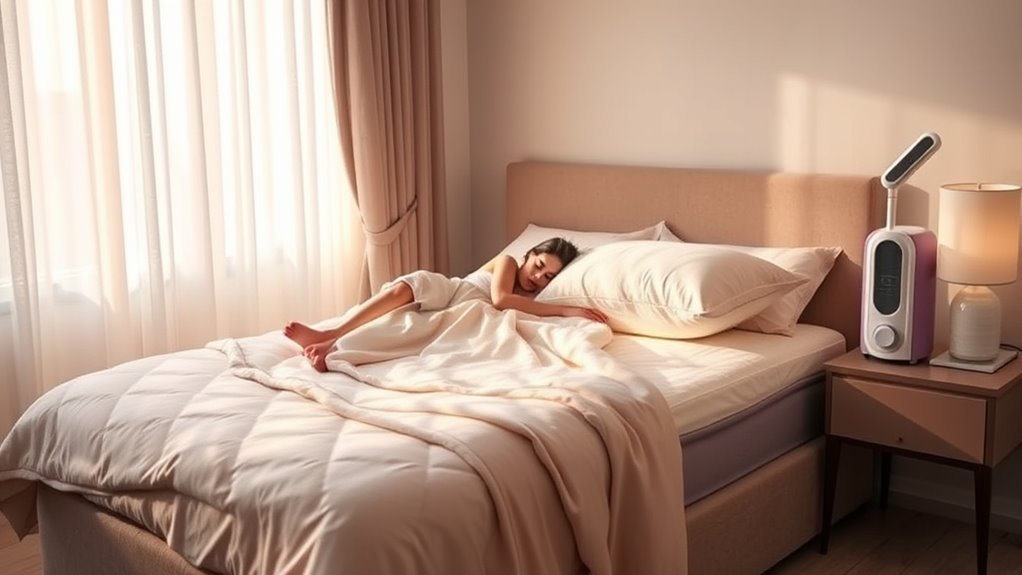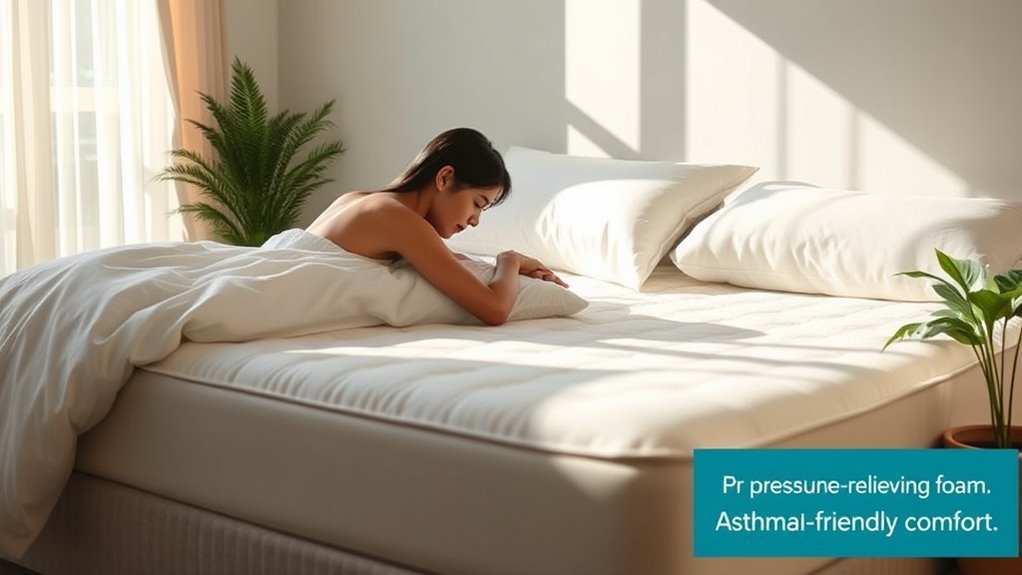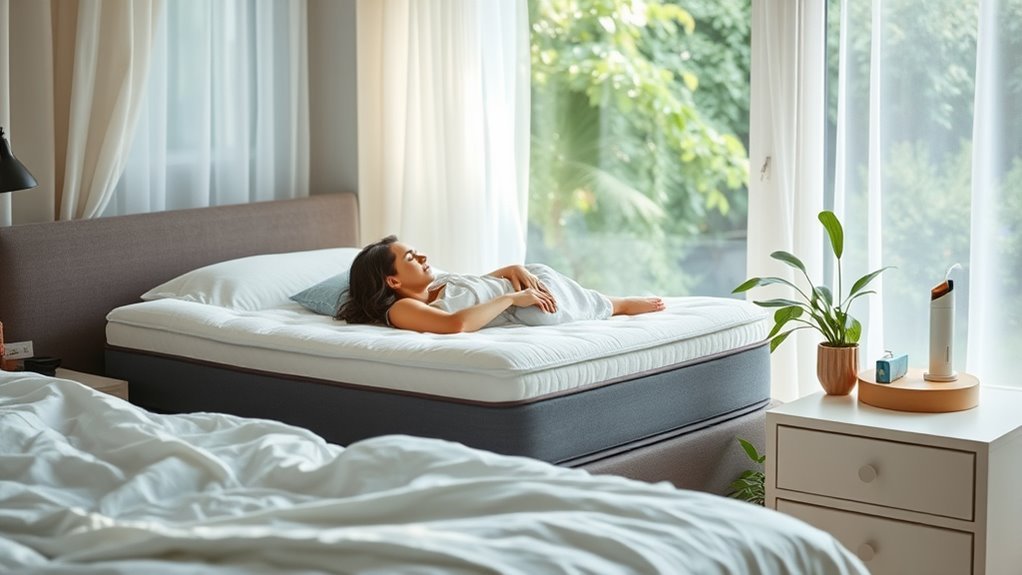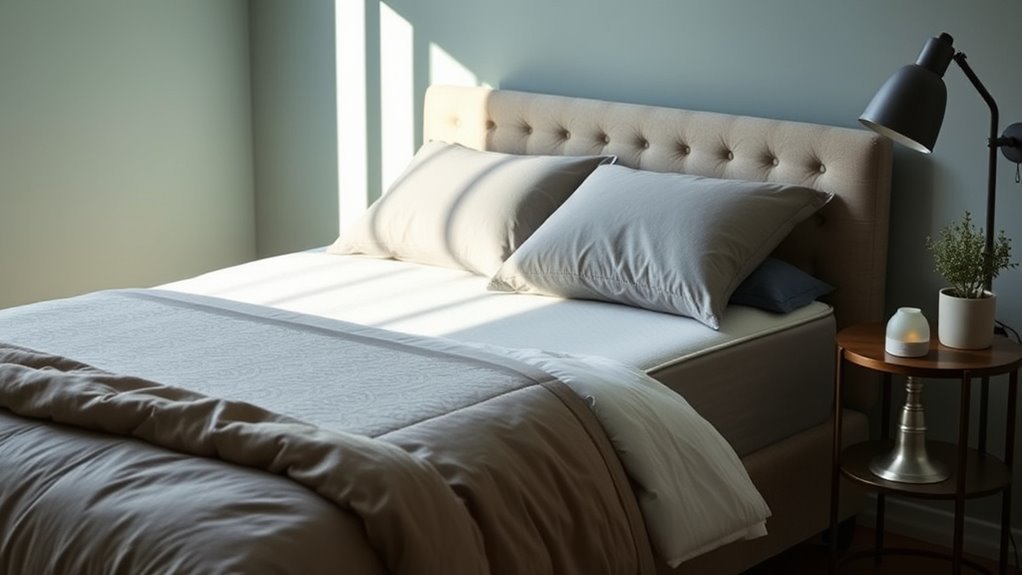When choosing a mattress as a side sleeper with asthma, prioritize breathability and pressure relief. Look for materials like memory foam or latex that contour to your body while staying hypoallergenic. Medium firmness often works best for support and spinal alignment. Guarantee the mattress has good ventilation to keep you cool and comfortable, reducing asthma triggers. Consider models with trial periods and strong warranties for peace of mind. There’s more to explore about features that enhance your sleep.
Understanding the Needs of Side Sleepers

When you sleep on your side, your body requires specific support to maintain proper alignment and alleviate pressure points. As a side sleeper, you’re likely to experience a unique set of needs that demand attention. Choosing the right mattress can greatly enhance your sleep quality, offering side sleeper benefits like improved spinal alignment and reduced discomfort. Look for a mattress that contours to your body while providing adequate support for your hips and shoulders. This balance is essential for maintaining proper mattress alignment, which minimizes the risk of waking up with aches or pains. By investing in a suitable mattress, you empower yourself to enjoy restful, rejuvenating sleep that aligns with your desire for freedom and comfort.
Importance of Pressure Relief

While you might not realize it, pressure relief is essential for a restful night’s sleep, especially for side sleepers. When you lie on your side, your body creates pressure points at areas like your shoulders and hips. Without proper support, this can lead to discomfort and hinder your ability to fall asleep or stay asleep. A mattress that offers effective pain relief guarantees that these pressure points are cushioned, allowing for better alignment of your spine. When you wake up refreshed, you’re free to tackle the day ahead. Investing in a mattress designed for pressure relief not only enhances your comfort but also contributes to your overall well-being, especially for those managing asthma. Choose wisely, and sleep soundly.
The Role of Mattress Materials

Choosing the right mattress goes beyond just pressure relief; the materials used can greatly impact your comfort and health. For side sleepers with asthma, memory foam offers excellent contouring, reducing pressure points while providing support. However, consider latex benefits as well—it’s naturally hypoallergenic and resistant to dust mites, which can be vital for your respiratory health. If you seek versatility, hybrid options combine the best of both worlds, offering support from coils and comfort from foam or latex. Additionally, opting for organic materials can minimize exposure to harmful chemicals, promoting a healthier sleep environment. Ultimately, selecting the right materials can empower you to enjoy restful nights without compromising your well-being.
Breathability and Temperature Regulation
When choosing a mattress, breathability and temperature regulation are essential for side sleepers with asthma. You need materials that allow air to flow freely and help maintain a comfortable sleeping temperature, as overheating can exacerbate respiratory issues. Prioritizing these features can lead to a more restful night and better overall health.
Material Breathability Importance
Since side sleepers with asthma often experience heightened sensitivity to allergens and temperature fluctuations, the breathability of mattress materials becomes essential for a restful night’s sleep. You’ll want to prioritize mattress ventilation to guarantee air flows freely through the materials, reducing moisture buildup and trapping allergens. Look for fabric types like cotton, bamboo, or specialized cooling foams that promote airflow. These materials not only help keep your sleeping environment comfortable but also minimize the risk of triggering asthma symptoms. A breathable mattress can make all the difference, allowing you the freedom to sleep soundly without worrying about allergens or temperature changes affecting your health. Choosing the right materials is key to guaranteeing you wake up refreshed and ready to embrace the day.
Temperature Control Features
To guarantee a comfortable night’s sleep, especially for side sleepers with asthma, it’s important to take into account temperature control features in a mattress. Look for options that incorporate cooling technologies, which help regulate body heat and prevent overheating. These features can greatly enhance your sleep quality, allowing you to breathe easier throughout the night. Additionally, consider mattresses made with moisture-wicking fabrics. These materials draw moisture away from your body, keeping you dry and comfortable. When you choose a mattress designed with these elements, you’re investing in your well-being and freedom from discomfort. A well-ventilated, temperature-regulating mattress can make all the difference in achieving a restful sleep, vital for managing asthma symptoms effectively.
Firmness Levels for Optimal Support
Finding the right firmness level in a mattress is vital for side sleepers, especially those managing asthma. You need a balance between comfort and support to guarantee your spine remains aligned while alleviating pressure points. Medium to medium-firm mattresses often provide this ideal balance. Look for mattress construction that includes quality support systems, such as memory foam or hybrid designs, which contour to your body shape while maintaining necessary support. This can help reduce tossing and turning, ultimately improving your sleep quality. Remember, the right firmness can also contribute to better airflow, which is significant for asthma sufferers. So, take your time exploring options that enhance both your comfort and respiratory health.
Allergens and Asthma-Friendly Features
When selecting a mattress, it is crucial to evaluate allergens and asthma-friendly features that can greatly impact your respiratory health. Look for allergy-free materials and hypoallergenic covers to minimize exposure to dust mites and other irritants. These elements can provide a safer sleeping environment, allowing you to breathe easier at night.
| Feature | Importance |
|---|---|
| Allergy-Free Materials | Reduces allergens in your sleep space |
| Hypoallergenic Covers | Protects against dust mites and mold |
| Breathable Fabrics | Promotes airflow, reducing humidity |
| Easy to Clean | Simplifies maintenance and hygiene |
| Non-Toxic Foams | Eliminates harmful chemical emissions |
Choosing wisely can lead to a restful night’s sleep, giving you the freedom to wake up refreshed and ready for the day.
Trial Periods and Warranty Considerations
When selecting a mattress, understanding trial periods and warranty considerations is essential for your peace of mind. A generous trial period allows you to assess comfort and support for your asthma needs, while a solid warranty guarantees protection against defects. Make certain you’re also clear on the return policy details so you can make an informed choice.
Importance of Trial Periods
Although choosing the right mattress can feel overwhelming, understanding the importance of trial periods and warranties can greatly enhance your decision-making process. Trial periods allow you to engage in mattress testing, ensuring that the bed truly meets your needs as a side sleeper with asthma. You can assess comfort and support without the pressure of a quick purchase. Customer feedback during these periods reveals how others with similar concerns have fared, giving you valuable insights. Additionally, you’ll have the freedom to make adjustments or return the mattress if it doesn’t suit you. This risk-free experience empowers you to prioritize your health and sleep quality, ultimately leading to a more informed and satisfying choice.
Warranty Length and Coverage
A solid warranty can provide peace of mind as you navigate the process of selecting a mattress, especially for side sleepers with asthma. It’s vital to understand the warranty details, as they often indicate the manufacturer’s confidence in their product. Look for coverage options that include defects in materials and workmanship, as well as specific terms that cater to your needs. A longer warranty typically signals durability, but make sure it covers potential issues that may arise, like sagging or loss of support. Remember, an extensive warranty not only protects your investment but also allows you to sleep soundly, knowing that your mattress is designed to last. Choose wisely, and prioritize warranties that reflect the quality you deserve.
Return Policy Details
Understanding the return policy is essential, especially for side sleepers with asthma, since it offers a safety net if the mattress doesn’t meet your needs. Here are some key return policy options to take into account:
- Trial Period: Look for mattresses with an extended trial period, ideally 100 nights or more.
- Exchange Process: Verify the company provides a simple exchange process if your mattress isn’t right.
- Return Shipping Fees: Check if you’ll have to pay for return shipping; some brands cover this cost.
- Condition Requirements: Understand what condition the mattress must be in to qualify for a return.
These details can help you make an informed decision and guarantee your investment aligns with your comfort and health needs.
Frequently Asked Questions
How Often Should I Replace My Mattress for Asthma Management?
You should replace your mattress every 7 to 10 years to effectively manage asthma. Did you know that nearly 20 million Americans suffer from asthma? An old mattress can harbor dust mites and mold, which are significant asthma triggers. By staying within that mattress lifespan, you’ll not only guarantee comfort but also create a healthier sleep environment. Don’t let allergens rob you of restful nights; prioritize your well-being with a fresh mattress.
Can Mattress Toppers Improve Comfort for Side Sleepers With Asthma?
Yes, mattress toppers can greatly improve your comfort as a side sleeper. By choosing toppers made from materials like memory foam or latex, you’ll experience enhanced pressure relief, which helps alleviate discomfort in your shoulders and hips. This added layer can also provide a softer surface, promoting better spinal alignment. Just verify the topper is hypoallergenic to support your asthma management, allowing you to sleep easier and wake up refreshed.
What Is the Best Sleeping Position for Asthma Sufferers?
Have you ever wondered what the best sleeping positions are for asthma relief? For many, sleeping on your back with your head elevated can help open airways, while side sleeping may reduce snoring and improve sleep quality. Avoiding stomach sleeping is essential, as it can constrict breathing. Finding the right position tailored to your comfort can empower you to breathe easier at night, allowing you to wake up refreshed and ready to tackle the day.
Are There Specific Brands Recommended for Side Sleepers With Asthma?
When choosing a mattress, consider brands like Purple, Saatva, and Tempur-Pedic. They offer materials like memory foam or latex, which contour well for side sleepers while providing support. Brand comparisons show that these options reduce pressure points, enhancing comfort for asthma sufferers. Look for hypoallergenic materials to minimize allergens. Ultimately, it’s about what suits your personal needs, so test different mattresses to find the one that gives you the best night’s sleep.
How Can I Maintain My Mattress to Reduce Allergens?
To keep allergens at bay, think of your mattress as a precious island in a sea of dust. Start by investing in allergen covers that act like a protective fortress. Establish a cleaning routine—vacuum the mattress monthly and wash your bedding weekly in hot water. Don’t forget to air out your mattress occasionally; it’s like giving it a revitalizing breeze. With these steps, you’ll create a cleaner, healthier sleep environment.



